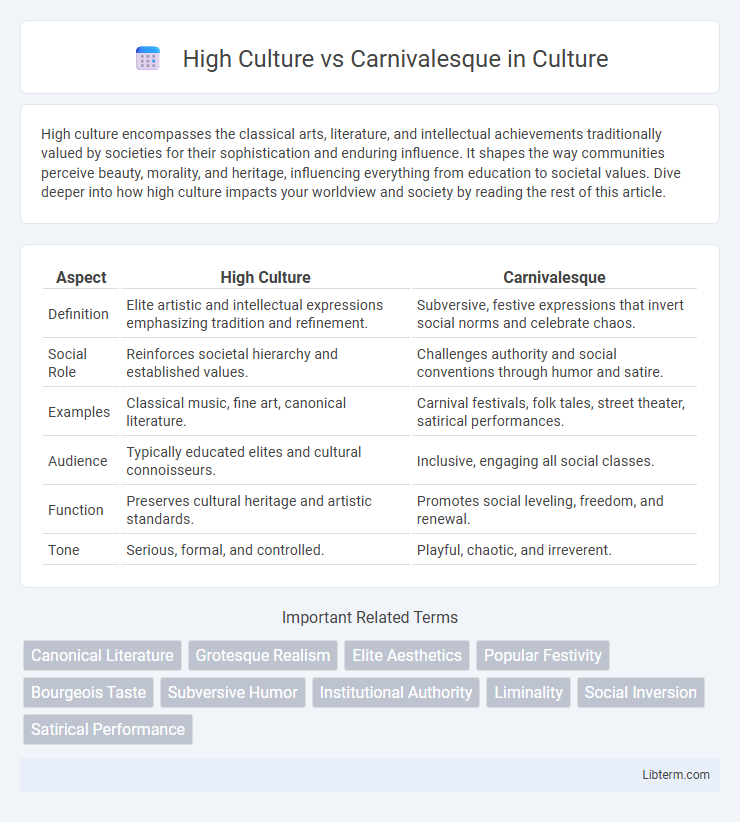High culture encompasses the classical arts, literature, and intellectual achievements traditionally valued by societies for their sophistication and enduring influence. It shapes the way communities perceive beauty, morality, and heritage, influencing everything from education to societal values. Dive deeper into how high culture impacts your worldview and society by reading the rest of this article.
Table of Comparison
| Aspect | High Culture | Carnivalesque |
|---|---|---|
| Definition | Elite artistic and intellectual expressions emphasizing tradition and refinement. | Subversive, festive expressions that invert social norms and celebrate chaos. |
| Social Role | Reinforces societal hierarchy and established values. | Challenges authority and social conventions through humor and satire. |
| Examples | Classical music, fine art, canonical literature. | Carnival festivals, folk tales, street theater, satirical performances. |
| Audience | Typically educated elites and cultural connoisseurs. | Inclusive, engaging all social classes. |
| Function | Preserves cultural heritage and artistic standards. | Promotes social leveling, freedom, and renewal. |
| Tone | Serious, formal, and controlled. | Playful, chaotic, and irreverent. |
Defining High Culture: Origins and Characteristics
High culture originates from classical traditions and elite social classes, emphasizing refined artistic expressions such as literature, classical music, and fine arts, which symbolize intellectual achievement and social prestige. It is characterized by its formal structures, complexity, and association with authoritative institutions like universities, museums, and conservatories. The preservation and promotion of high culture often reinforce cultural hierarchy, distinguishing it from popular or folk traditions.
The Essence of the Carnivalesque Tradition
The essence of the carnivalesque tradition lies in its subversion of hierarchical norms and the celebration of chaos, humor, and collective liberation, contrasting sharply with the rigid structures of high culture. Rooted in the theoretical framework established by Mikhail Bakhtin, the carnivalesque dismantles official ideologies through parody, grotesque realism, and festive inversion, creating a space where social roles and conventions are temporarily suspended. This tradition emphasizes the communal and liberating aspects of culture, highlighting the fluidity of identity and the power of laughter to challenge authority and provoke social change.
Historical Evolution: High Culture vs. Carnivalesque
High culture emerged from elite traditions rooted in classical art, literature, and formal rituals that evolved during the Renaissance and Enlightenment periods, emphasizing order, hierarchy, and intellectualism. Carnivalesque culture, popularized by Mikhail Bakhtin's theories, traces its origins to medieval festivals and folk traditions that embraced chaos, humor, and social inversion as a form of resistance against established authority. Over time, the dynamic interplay between high culture and carnivalesque has shaped cultural history by juxtaposing structured refinement with subversive popular expression.
Power, Authority, and the Role of High Culture
High culture embodies established power and authority by promoting refined art forms, intellectualism, and societal norms that reinforce hierarchical structures. It often serves as a gatekeeper, preserving elite status and controlling cultural narratives through institutions like museums, opera houses, and academia. In contrast, the carnivalesque subverts these power dynamics by embracing chaos, humor, and popular expression, challenging the legitimacy of high culture and democratizing cultural participation.
Subversion and Satire: The Carnivalesque Approach
The Carnivalesque approach employs subversion and satire to challenge established norms and hierarchies inherent in high culture, using humor, chaos, and reversal of roles to undermine authority and promote social critique. This literary and cultural mode disrupts traditional power structures by celebrating the grotesque, the profane, and the marginalized, creating a space where dominant values are questioned and reinterpreted. Through parody and the grotesque body, it reveals the contradictions and absurdities of elite cultural institutions, fostering a democratizing effect that contrasts sharply with the exclusivity of high culture.
Art Forms and Aesthetic Differences
High culture in art forms emphasizes classical traditions, refined techniques, and elite aesthetic standards often linked to institutions like museums and opera houses. Carnivalesque art embraces subversion, humor, and popular culture, breaking conventional norms through performances such as street theater, folk festivals, and satirical literature. These aesthetic differences highlight high culture's focus on order and permanence versus carnivalesque's transient, chaotic, and communal experiences.
Social Hierarchies and Accessibility
High culture often reinforces social hierarchies by emphasizing elitist art forms like classical music, fine art, and literature accessible primarily to privileged groups. Carnivalesque culture disrupts these hierarchies through humor, satire, and communal participation, creating spaces where social norms and status distinctions are temporarily inverted. This accessibility democratizes cultural expression, allowing marginalized voices to challenge dominant power structures and foster social critique.
Contemporary Manifestations in Media and Art
High culture in contemporary media often emphasizes classical art forms, elite literature, and refined performances, reinforcing social hierarchies and intellectual exclusivity. Carnivalesque elements disrupt this norm, embracing grotesque humor, subversion, and popular culture in street art, film, and digital platforms to challenge authority and celebrate collective freedom. The interplay between high culture and carnivalesque in modern art scenes generates dynamic dialogues on identity, power, and cultural values.
Cultural Conflicts and Mutual Influences
High culture, characterized by elite artistic and intellectual pursuits, often contrasts sharply with carnivalesque traditions that emphasize subversion, humor, and collective festivity. Cultural conflicts arise as high culture enforces norms of refinement and exclusivity, while carnivalesque practices challenge social hierarchies through parody and chaos. Despite tension, mutual influences emerge as elements of carnivalesque disrupt and inspire high culture, fostering dynamic cultural exchanges and hybrid forms.
The Future of High Culture and Carnivalesque Dynamics
The future of high culture will increasingly integrate carnivalesque dynamics, blending traditional elite aesthetics with popular, subversive expressions that challenge established norms. Emerging digital platforms and social media amplify carnivalesque practices, democratizing cultural participation and reshaping the boundaries of high culture through interactive, hybrid cultural forms. This fusion fosters a dynamic cultural landscape where hierarchical distinctions blur, enabling more inclusive, diverse expressions and critical dialogues within contemporary art, literature, and performance.
High Culture Infographic

 libterm.com
libterm.com